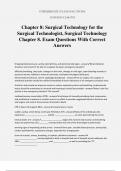©THEBRIGHT EXAM SOLUTIONS
11/05/2024 12:06 PM
Chapter 8: Surgical Technology for the
Surgical Technologist, Surgical Technology
Chapter 8. Exam Questions With Correct
Answers
Dropping blood pressure, cardiac dysrhythmia, and abnormal vital signs - answer✔What indicators
should an entry-level ST be able to recognize during an emergency situation?
difficulty breathing, chest pain, changes in skin color, changes in vital signs, open bleeding wounds or
puncture wound, inability to move an extremity, misshapen/misaligned body part,
disorientation/confusion, severe cephalagia (headache) - answer✔Prior to surgery, the surgeon or
anesthesia provider should be notified immediately if these indications of an emergency situation arise:
check for and provide an airway to ensure or restore respiratory status and breathing; cardiovascular
status should be maintained or restored and hemostasis should be provided - answer✔What is the first
priority in any emergency situation? The second?
cardiopulmonary resuscitation (CPR) - answer✔a technique of manually providing chest compression
and ventilations to patients in cardiac arrest in an effort to provide oxygenated blood to the brain and
vital organs and reverse the processes that lead to death
CPR or Basic Life Support (BLS) - answer✔renewed every 2 years
sudden cardiac arrest (SCA), ventricular fibrillation (VF) - answer✔Many of the individuals who
experience ____________________ exhibit __________________ at some point during the arrest.
Clinical death, 4-6 - answer✔___________________ begins the moment heart action and breathing
stops; the patient has only ________ minutes before the cells of the brain begin to deteriorate.
warning signs of impending cardiac arrest - answer✔chest pain, unstable blood pressure, tachycardia,
cardiac dysrhythmias, respiratory changes, hypovolemia, laryngospasm
chain-of-survival, airway, breathing, circulation, definitive treatment - answer✔A
____________________ concept applied to both in-hospital and out-of hospital arrests addresses the
ABCs- ____________, ____________, and ______________-as well as providing the "D",
____________________.
, ©THEBRIGHT EXAM SOLUTIONS
11/05/2024 12:06 PM
successful resuscitation requires: - answer✔early recognition/activation/CPR/defibrillation/advanced
cardiac life support (ACLS)
protect the sterile field - answer✔In the OR, the surgical technologist's primary function is to
______________________.
Guidelines for Cardiopulmonary Resuscitation and Emergency Cardiovascular Care - answer✔In 2010 the
AHA published the revised ___________________________ that includes significant changes from the
2005 version.
A-B-C (airway, breathing, chest compressions), C-A-B (chest compressions, airway, breathing) -
answer✔A change in the sequence of BLS from _________________ to __________________ for adults,
adolescents, and infants (excludes newborns).
tap the shoulder - answer✔The HCP should no longer shake the victim, but rather __________________
and shout, "Are you all right?"
chest compressions, rescue breaths - answer✔Immediately start ________________ before giving
___________________.
complete recoil - answer✔Focus on delivering high-quality chest compressions at the appropriate rate
and depth, including ____________________ of the chest after each compression.
30:2 - answer✔The ratio of chest compressions to rescue breaths for infants, adolescents, and adults is
_______.
"push hard, push fast", 100 - answer✔The new concept _____________________ is to be applied to
CPR. The recommendation is at least _____ compressions per minute.
2, five, 5 - answer✔When two or more rescuers are available, it is recommended to switch chest
compressors every ___ minutes, or about every ______ cycles of compressions an ventilations. The
switch should be made in less than ___ seconds.
head tilt-chin lift, jaw thrust - answer✔HCP should use the ___________________ maneuver to open
the airway. If a spine injury is suspected, the airway should be opened using a ____________ without
head movement.
regurgitation, aspiration - answer✔Excessive ventilation must be prevented in order to avoid the
complications including _____________________ and ____________________.
AED - answer✔automated external defibrillator
10 - answer✔Take no more than ____ seconds to check if a pulse is present.
asphyxial - answer✔The majority of pediatric cardiac arrests are _________________; resuscitation
should be a combination of ventilation and chest compressions.




